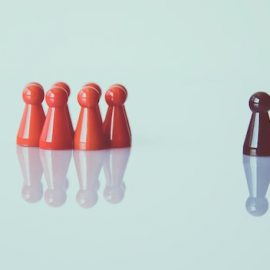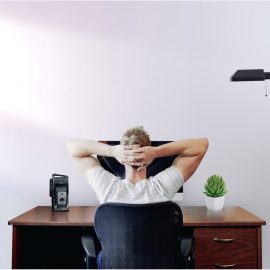

This article is an excerpt from the Shortform book guide to "The Dictator's Handbook" by Bruce Bueno de Mesquita and Alastair Smith. Shortform has the world's best summaries and analyses of books you should be reading.
Like this article? Sign up for a free trial here.
How do political leaders come to power? How do they maintain it? What makes someone a dictator rather than a democrat?
People often discuss political leaders in terms of their ideologies, their dedication to their people, or their backgrounds. To understand the choices leaders make, though, you need to consider only one thing: their desire for power.
Continue reading for an overview of the eye-opening book The Dictator’s Handbook by Bruce Bueno de Mesquita and Alastair Smith.
Overview of The Dictator’s Handbook
In The Dictator’s Handbook, political scientists Bruce Bueno de Mesquita and Alastair Smith argue that the primary goal of all leaders is to get power and hold onto it as long as possible. This is true in all political systems—the differences between them come from how their leaders gain power and who they’re accountable to. Bueno de Mesquita and Smith illustrate this by comparing democracies and dictatorships throughout the book, concluding that the greater accountability of democracy leaves the people better off.
(Shortform note: The authors present a form of realpolitik, an approach to politics arguing that political actors are motivated by practical considerations of power rather than any higher moral or ideological beliefs. However, realpolitik refers to governments as a whole acting pragmatically in the interest of the entire nation. The authors take a more zoomed-in view on the specific interests of individual politicians, arguing that they take priority over any nationwide interest.)
Our overview of The Dictator’s Handbook consists of four parts:
- Part 1: How Leaders Seize Power explains how dictators and democrats gather the support necessary to replace their existing governments.
- Part 2: How Leaders Stay In Power outlines how dictators and democrats maintain the loyalty of their supporters so they aren’t replaced.
- Part 3: How Leaders Interact describes how dictators and democrats manage allies and rivals at home and abroad.
- Part 4: Why Democracy Is Preferable argues that based on these differences in how leaders handle power, people are generally better off under democracy than they are under dictatorship.
Part 1: How Leaders Seize Power
Before leaders can wield power, they have to secure it. The authors explain that both dictators and democrats follow the same two-step process to seize power:
- Gather the support necessary to control the country
- Replace their country’s existing government
We explain why both of these steps are necessary and how different types of leaders follow them.
Step #1: Create a Power Bloc
The authors explain that to secure power, a leader must first create a power bloc: a group of supporters capable of taking control of and running the country. No leader can run a country on their own—even if they make every political decision, they still need others to carry out and enforce their will. Leaders create power blocs by promising potential supporters more influence and wealth than they have under the current government.
The authors argue that leaders want their power blocs to be small, as this makes their power dependent on a few individuals they can control more easily than large groups. However, depending on their path to power and the government they create or inherit, they may end up with much larger power blocs. Let’s examine some of the key differences between small and large power blocs and the leaders who create them.
Dictators: Small Power Bloc Leaders
The authors define dictators as leaders with small power blocs consisting ofa few influential politicians, bureaucrats, or military officers. These figures provide the influence, money, and manpower necessary to take control of the government. Would-be dictators secure a power bloc by promising these key allies personal enrichment and high-up positions in the new government. For example, Iraqi dictator Saddam Hussein created a power bloc consisting of high-ranking members of his party and the Iraqi military and security state. He did so by channeling Iraq’s oil wealth into projects that benefited his allies.
Democrats: Large Power Bloc Leaders
On the other hand, the authors describe leaders with large power blocs as democrats. Their power blocs consist of a significant portion of their country’s population. While each individual supporter may not have as much power or wealth as a high-ranking politician, large power blocs collectively have enough to take control of the government. Potential democratic leaders secure support by promising to distribute more wealth and power among the groups who back them.
For example, American politician John F. Kennedy created a power bloc of progressives, the working class, and Black Americans during the 1960 presidential election cycle. He attracted this significant portion of the American public by promising to pass anti-poverty initiatives and liberal social reforms that would directly benefit them.
Step #2: Replace the Existing Government
The authors explain that once a potential leader has secured a power bloc, they can replace their country’s existing government. There are two main methods of doing so, which dictators and democrats approach in different ways:
Method #1: Force
The authors explain that a leader can leverage the strength of their power bloc to oust the existing government. This often occurs when a country lacks a formal route for a new leader or power bloc to take charge—for example, a dictator replacing a democracy or vice versa.
Dictators accomplish this by using their small power blocs to quickly seize key infrastructure, kill, arrest, or exile members of the existing government, and declare themselves in charge to the public. For example, in 1977, Pakistani leader Muhammad Zia-ul-Haq, backed by the firepower and authority of his supporters in the military, took control of the country’s communications infrastructure, arrested key members of Pakistan’s democratic civilian government, and declared military rule.
Democrats accomplish this by mobilizing their large power blocs to participate in mass movements and popular revolutions, taking control of the country through sheer numbers. For example, Jawaharlal Nehru became India’s first prime minister in 1947 after helping to organize decades’ worth of mass strikes, boycotts, and other demonstrations. These effectively shut down the country, giving the Indian independence movement the leverage it needed to force the dictatorial colonial British government to withdraw from the country.
Method #2: Political Institutions
Leaders can also replace their country’s existing government by using political institutions that are already in place. These institutions provide a formal route for a new leader or power bloc to gain power.
Dictators accomplish this by using the influence of their power blocs to take control of institutions closed off to the general public. These include closed-off elections, rigged popular elections, and bureaucratic systems for leaders to appoint their successors. For example, Soviet leader Leonid Brezhnev gained a leadership position in the Soviet Union in 1964 when his power bloc won him an election open only to members of the Communist Party of the Soviet Union.
Democrats use existing institutions by leveraging their power blocs to win a majority or plurality of votes in a popular, free, and fair election. Some democracies have the people vote directly for a leader, while others have people elect representatives who then vote for a leader from among themselves. For example, in 2023, Luiz Inácio Lula da Silva replaced Jair Bolsonaro as president of Brazil after winning a majority of votes in the 2022 Brazilian general election.
Part 2: How Leaders Stay In Power
The authors explain that, after seizing power, leaders must work consistently to stay in power. This requires ensuring continued loyalty from their power bloc—otherwise, they won’t be able to control the country and would risk being replaced. According to the authors, leaders use three main methods to ensure the loyalty of their power blocs:
- Reward support
- Punish dissent
- Pacify revolts
We focus on how both dictators and democrats use these methods to stay in power.
Method #1: Reward Support
The most reliable way leaders maintain loyalty is by providing their power bloc with political and economic benefits. As long as a leader keeps “paying out,” their supporters will have little interest in turning on them. In addition, leaders often must provide some baseline level of public goods to their whole population to keep people productive and prevent outright revolt.
The authors explain that dictators and democrats reward supporters and provide public goods in different ways:
How Dictators Reward Support
Dictators provide members of their small power blocs with high-ranking political positions and large amounts of money. The authors argue that dictators generate the money necessary for this through a combination of high taxes, loans from foreign nations and institutions, wealth generated from natural resource extraction, and corrupt deals with private companies.
For example, dictator Mobutu Sese Seko of the Democratic Republic of the Congo rewarded his loyal supporters by giving them control of state industries, directly bribing them, or permitting them to engage in corruption. He sustained this with international loans, cuts to salaries of low-level state employees, and profits from the sale of natural resources like copper.
How Democrats Reward Support
Democrats reward members of their large power blocs through one (or both) of the following ways:
- Buying votes: Some democrats bribe individuals for their votes, offering money, free meals, or other small rewards.
- Beneficial policies and projects: Most democrats reward their power blocs indirectly by passing policies and pursuing projects that benefit them. For example, a democrat might cut taxes for groups in their power bloc or improve the infrastructure of a region that supported them.
Democrats are more constrained than dictators when it comes to generating money for rewards because they’re responsible to far more supporters. This means they can’t tax as many people freely without losing support. In addition, their responsibility makes it more difficult for them to borrow money irresponsibly or engage in corruption, since the public bears the burden of excessive debt or misused taxed dollars. To work around these constraints, democrats place the tax burden on people outside of their power bloc and borrow as much as they reasonably can.
How Dictators and Democrats Use Public Goods
In addition to specifically rewarding supporters, both dictators and democrats provide public goods—things like public education, nationalized health care, municipal water systems and so on—to keep their populations productive and pacified. Public goods like health care and education increase labor productivity, boosting economic activity and therefore providing a larger pool of wealth the government can tax. The improved quality of life from public goods also means that people outside of the power bloc will be less desperate and therefore less likely to revolt against the government.
The authors argue that because of their larger power blocs, democrats tend to invest more in better public goods than dictators. Democrats are accountable to a larger portion of their populations because they have larger power blocs. Since public goods benefit the entire population, they offer democrats a better ratio (compared to dictators) of money spent on the power bloc to money spent on people outside of it. Therefore, they’re more willing to invest money into public goods.
Method #2: Punish Dissent
The authors explain that, in addition to rewarding supporters, leaders can maintain loyalty by punishing dissenters and political rivals. When supporters know that harsh punishment is the consequence of disloyalty, they’ll be less likely to step out of line. For dictators, punishments for individual dissenters can include death, imprisonment, firing, or demotion. Democrats, on the other hand, can use the legal system to try and disqualify opposing votes, intimidate or attack voters in areas that support their rivals, or limit and cut government services to those areas.
Keep Supporters Replaceable
For punishments to be truly effective, leaders must make sure everyone in their power bloc is replaceable. If the leader relies too heavily on one supporter or one group of supporters, then those supporters will have much more leverage over them. The supporters can use this leverage to express dissent more freely, demand more rewards, or even to secure their own support and take over the country. But, if everyone in a power bloc is replaceable, the threat of punishment will be far more effective—the leader can easily arrest or fire individuals because there are plenty of loyal people willing to replace them.
Method #3: Pacify Revolutions
When leaders fail to use rewards and punishments correctly, or when circumstances outside of their control—a global economic crash, for example—cause unrest, the population at large can revolt against them. The authors assert that revolutions are dangerous times for leaders and require careful political management.
Why Revolutions Happen
To understand how leaders manage revolutions, it helps to first understand why they occur. The authors argue revolutions happen most often in countries with medium-sized power blocs—dictators who allow some popular political participation, or democrats who partially limit or bypass it. Such leaders need both some popular support and some support from higher level military or bureaucratic figures to stay in power.
In these regimes, supporters are incentivized to shrink or expand the power bloc: If they shrink it, remaining supporters will get a larger share of rewards. If they expand it, they’ll benefit from increased public goods (and the revenue, productivity, and quality of life associated with those public goods). Medium-sized power blocs also make it harder for leaders to get away with harsh repressive tactics, since they have some degree of accountability to their population. This means their power bloc is more likely to respond to repression by pulling support or replacing their leader.
How Leaders Manage Revolutions
The authors explain that because medium-sized power blocs are more susceptible to revolts, their leaders respond to popular revolutions by either shrinking or growing their power blocs in whatever way keeps them in power. If they have the necessary manpower to control the population, they can shrink their power bloc by brutally repressing the revolt. If they don’t have the manpower, they can appease the revolutionaries through liberalizing political reforms—increasing the size of their power blocs.
For example, the Soviet Union responded to the Hungarian Revolution of 1956 by shrinking its power bloc. The leadership killed and arrested thousands of protesters, replaced the Hungarian government with one far more loyal to Soviet interests, and permanently kept troops in the country. On the other hand, Beninese dictator Mathieu Kérékou responded to growing unrest by transitioning Benin into a larger power bloc multiparty democracy in the late 80s, and—after briefly being ousted from power—was elected president in 1996.
Part 3: How Leaders Interact
While the size and composition of power blocs determine a leader’s domestic politics, the authors argue that power blocs influence international politics as well. Leaders are both constrained by the needs of their power blocs and encouraged to pursue their interests abroad.
We discuss how leaders secure alliances and wage wars to best serve their power blocs, again comparing the approaches of dictators and democrats.
Securing Allies
The authors argue that leaders choose allies that help secure their economic and political interests. This often means allying with whoever pays best or asks for the least. Dictators are generally easier to “buy” an alliance with than democrats, as they don’t have to worry about whether an alliance is broadly popular in their country. This is why democrats will cooperate with dictators and in some cases even oppose democratization abroad: Dictators are cheaper and don’t need broad public support to pursue a desired goal.
For example, the democratic US and Belgian regimes covertly overthrew the Democratic Republic of Congo’s democratically elected leader Patrice Lumumba because they were concerned he would limit their access to the country’s resource wealth and ally with the Soviet Union. They replaced him with Mobutu Sese Seko, who—at least for a time—was willing to cooperate with US and Belgian interests.
Foreign Aid
According to the authors, the main purpose of foreign aid is to buy loyalty from other nations. While aid programs are often pitched to the public as ways of helping struggling peoples, they’re more often bribes to other leaders—especially in dictatorships, where leaders are free to misuse aid for their own purposes. This arrangement benefits both giver and recipient: The giver appears charitable to their people and the world public, while the recipient receives wealth they can appropriate or redistribute to their power bloc.
Waging War
While dictators and democrats choose allies in the same ways, the authors argue that they approach war differently. They compare when and how the two types of leaders wage war:
How Dictators Wage War
The authors argue dictators use wars as opportunities to quickly seize additional wealth or power. They’re willing and even likely to start a war—even against a difficult opponent—if they see such an opportunity. This is because the additional wealth will help them maintain the loyalty of their power bloc, while the popularity of a war or the safety of their soldiers is far less relevant to their continued hold on power.
However, dictators are unlikely to commit heavily to war if they encounter serious opposition. There are two main reasons for this: First, they need a constant domestic military presence to repress dissent, and fighting a difficult war would require them to divert some of these forces. Second, small power blocs are much more sensitive to any money diverted from rewards to war—a 10% reduction in rewards means a far larger loss to each member of a 50-person power bloc than it does to each member of a 500,000-person power bloc. Therefore, dictators can’t overcommit to wars militarily or financially without jeopardizing the loyalty of their power blocs.
How Democrats Wage War
On the other hand, democrats use wars as last resort methods of achieving foreign policy goals, explain the authors. For democrats, going to war is a careful calculation: Sending soldiers to their deaths unnecessarily or losing a war will cause them to lose support, but so will failing to achieve their foreign policy aims. To maximize their chance of remaining in power, democrats tend to declare war only when other options have failed and only when they believe they can win.
When democrats do wage war, they’re more likely to commit heavily when they face serious opposition. Their large power blocs mean that funding a war effort requires less sacrifice from each supporter. In addition, spending more on the war effort helps to protect the lives of soldiers and can turn a losing war into a victory—both of which are popular outcomes and will boost a democratic leader’s support.
For example, when the US war in Vietnam encountered heavy resistance, the US government devoted additional funds and troops and continued fighting for over a decade.
Part 4: Why Democracy Is Preferable
After comparing how dictators and democrats gain and use their power, the authors conclude that populations are better off under a democrat than they are under a dictator. This is because the larger a leader’s power bloc is, the closer their personal interests will align with the interests of the public. As previously stated, the main interest of any leader is staying in power, and keeping their power bloc happy is a crucial way to accomplish this. Therefore, a leader with a large power bloc is more accountable to the population at large, as they are personally incentivized to keep people happy through rewards, public goods, low taxes, less corruption and repression, and so on.
The authors acknowledge that not everyone can be happy in a democracy—different people in a society will inevitably have different interests. But in a more democratic world with larger power blocs, more people will be more happy more of the time.

———End of Preview———
Like what you just read? Read the rest of the world's best book summary and analysis of Bruce Bueno de Mesquita and Alastair Smith's "The Dictator's Handbook" at Shortform.
Here's what you'll find in our full The Dictator's Handbook summary:
- The two factors that truly distinguish one political system from another
- How leaders seize and stay in power in democracies and dictatorships
- The specific reason why democracy is better than dictatorship






